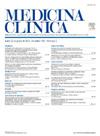Trombosis venosa profunda de miembros superiores en los pacientes hospitalizados portadores y no portadores de catéter venoso central: un estudio de cohortes retrospectivo
IF 2.6
4区 医学
Q1 MEDICINE, GENERAL & INTERNAL
引用次数: 0
Abstract
Objectives
Prognostic differences between central venous catheters (CVC) carriers and non-carriers, who have upper extremity deep vein thrombosis (UEDVT), have been described; however, evidence in hospitalized patients is limited.
Materials and methods
This retrospective cohort study included hospitalized patients from March 2012 to March 2023 with UEDVT, classified into CVC-associated and non-CVC-associated UEDVT groups. Rates of thrombotic recurrence, hemorrhage, post-thrombotic syndrome, and death from pulmonary embolism were analyzed using Kaplan-Meier curves and Cox proportional hazards models.
Results
A total of 135 patients were included (76 with CVC and 59 without CVC), with a mean age of 67 ± 15 years and 44% female. No significant differences were observed in the incidence of the combined endpoint between CVC non-carriers and carriers (5.45 vs 6.74 per 1000 patient-months respectively; HR: 1.26; 95% CI: 0.51-3.06). After multivariable adjustment, no significant differences in risk were detected (HR: 1.09; 95% CI: 0.44-2.72).
Conclusions
There are no significant prognostic differences between patients with and without CVC hospitalized for UEDVT.
住院中心静脉导管携带者和非携带者的上肢深静脉血栓形成:一项回顾性队列研究。
目的:中心静脉导管(CVC)携带者和非携带者在上肢深静脉血栓形成(UEDVT)的预后方面存在差异,但住院患者的证据有限:这项回顾性队列研究纳入了 2012 年 3 月至 2023 年 3 月期间患有 UEDVT 的住院患者,分为 CVC 相关 UEDVT 组和非 CVC 相关 UEDVT 组。研究采用 Kaplan-Meier 曲线和 Cox 比例危险模型分析了血栓复发率、出血率、血栓后综合征和肺栓塞致死率:共纳入135例患者(76例使用CVC,59例未使用CVC),平均年龄(67±15)岁,女性占44%。非 CVC 携带者和携带者的合并终点发病率无明显差异(分别为每 1000 患者月 5.45 例和 6.74 例;HR:1.26;95% CI:0.51-3.06)。经多变量调整后,未发现明显的风险差异(HR:1.09;95% CI:0.44-2.72):结论:因 UEDVT 住院的患者中,有 CVC 和没有 CVC 的患者在预后方面没有明显差异。
本文章由计算机程序翻译,如有差异,请以英文原文为准。
求助全文
约1分钟内获得全文
求助全文
来源期刊

Medicina Clinica
医学-医学:内科
CiteScore
3.10
自引率
5.10%
发文量
295
审稿时长
22 days
期刊介绍:
Medicina Clínica, fundada en 1943, es una publicación quincenal dedicada a la promoción de la investigación y de la práctica clínica entre los especialistas de la medicina interna, así como otras especialidades. Son características fundamentales de esta publicación el rigor científico y metodológico de sus artículos, la actualidad de los temas y, sobre todo, su sentido práctico, buscando siempre que la información sea de la mayor utilidad en la práctica clínica.
 求助内容:
求助内容: 应助结果提醒方式:
应助结果提醒方式:


